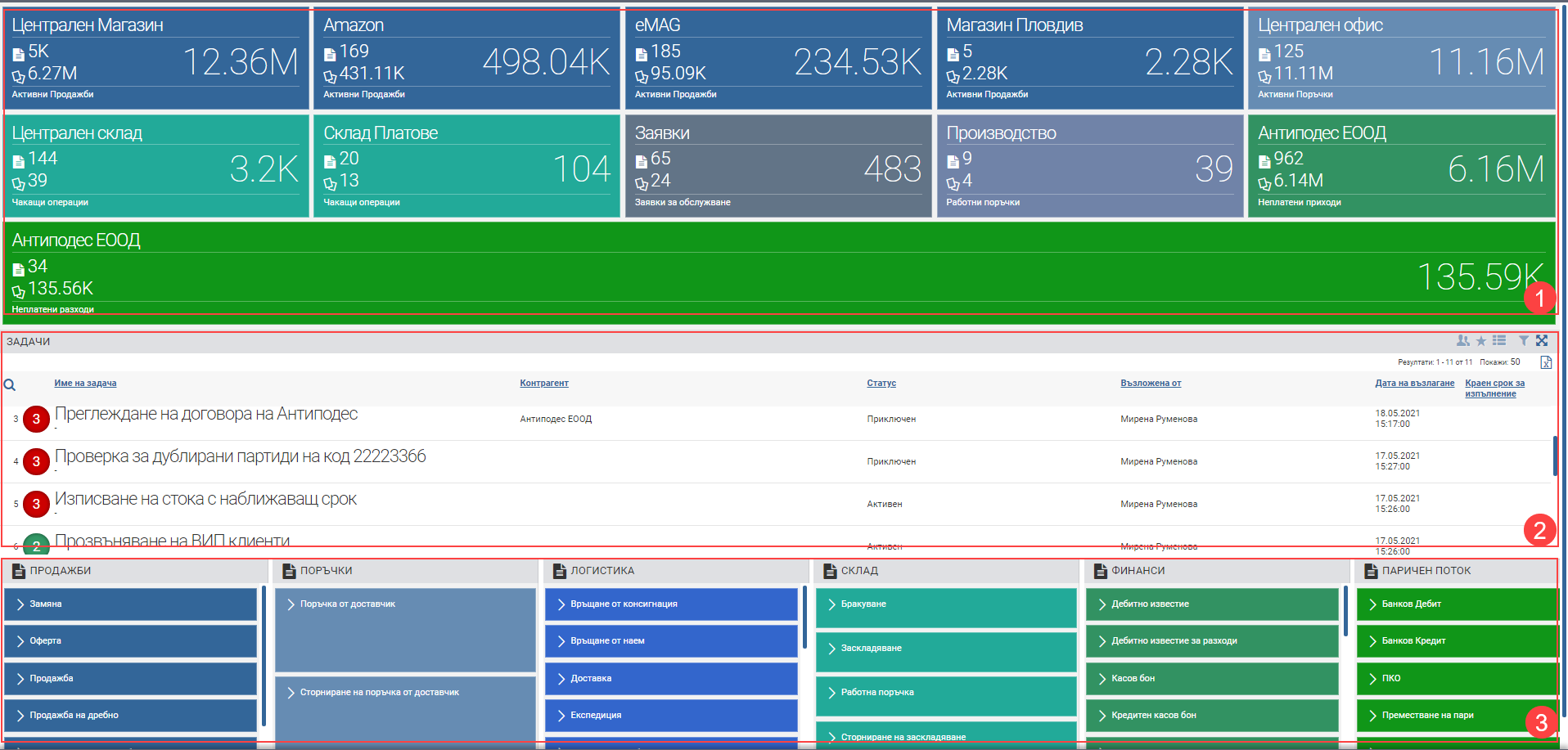The Operational Tasks screen is typically used as the home page after logging in and contains concentrated information and quick access to:
- Active sales/ orders/ requests/ work orders
- Pending warehouse operations
- Unpaid income/expenditure
- All tasks in three views
- Access all possible documents you are allowed to enter.
Dashboard Tasks is intended for use by all users in the system.
The interface consists of Summary (1), Tasks (2) and Documents (3):

Summary information (1)
Each field displays POS/warehouse/company, etc. information according to the user rights for the respective objects. In addition, the fields are also links referring to the main interfaces from which the information is generated.
| Field | Description | Rights | Link |
| Active sales | Displays active sales by POS and includes information on number of sales, total sales, invoicing amount. | The user needs to see the sales and be a POS merchant. | Lead to P&S > Sales > Sales. |
| Active orders | Displays active orders by office and includes information on number of orders, total orders, billing amount. | The user should be able to see the orders and be able to work with the office. | Leads to P&S > Orders > Orders. |
| Pending operations | Displays pending operations by warehouse and includes information on number of pending operations, number of pending items and unique items (you have 20 keyboards and 30 mice- unique items are 2-mouse and item). | The user must be MOL of stock. | Lead to Logistics > Warehouse > Pending Operations. |
| Active service requests | Displays active service requests and includes information on number of service requests, number of items to service, and number of unique items (you have 20 keyboards and 30 mice- unique items are 2-mouse and item). | The user should see service requests and be able to create orders. | Lead to Logistics > Warehouse > Service Requests. |
| Active work orders | Displays active work orders in production and includes information about the number of work orders, the number of products are in them, and the number of materials to put into them. | The user must be able to create work orders. | Lead to Logistics > Manufacturing > Work Orders. |
| Unpaid revenue | Displays the firm’s unpaid revenue by office and includes information on the number of unpaid financial documents, their total amounts, and the amount unpaid. | The user should be able to see invoices and work with the office. | Lead to Finance > Finance > Revenue. |
| Unpaid expenses | Displays the firm’s unpaid expenses by office and includes information on the number of unpaid financial documents, their totals, and the amount unpaid. | The user should be able to see invoices and work with the office. | Lead to Finance > Finance > Expenses.. |
Tasks (2)
Displays all tasks in a table with the following columns:
| Column | Description |
| Priority | Indicates with what priority the task is entered: – a figure 1 in grey means that the task is low priority; – a number 2 in green means that the task has normal priority; – a number 3 in red means that the task is high priority. |
| Name of task | Task name and task file. When you click on your name a task file opens. |
| Contractor | The contractor associated with the task. |
| Status | Shared task status. |
| Commissioned by | The user who created the task. |
| Date of award | Date of assignment. |
| Deadline for implementation | Deadline. |
You can choose how your tasks look from three views – as a list, in Shared Status view, or in Own Status view.
Documents (3)
At the bottom of the interface there are buttons to launch all documents/operations that you have permissions to issue. They are arranged by type – Sales, Orders, Logistics, Warehouse, Finance and Cash Flow.